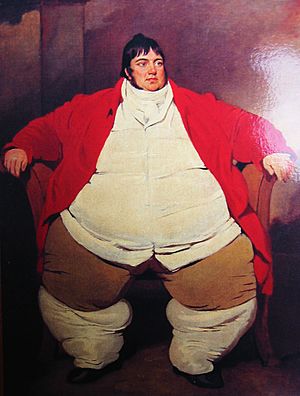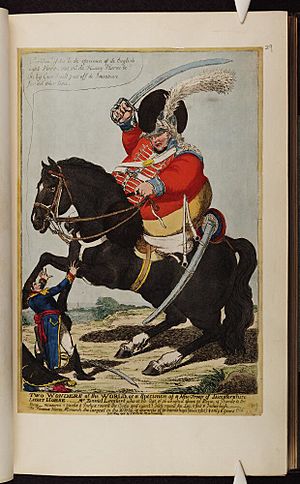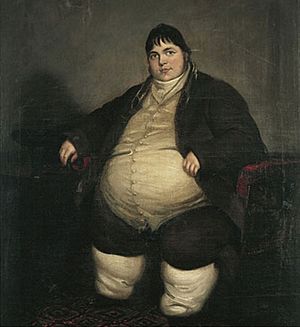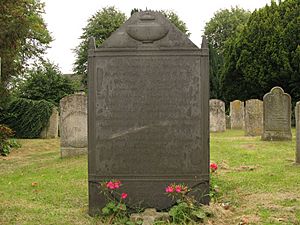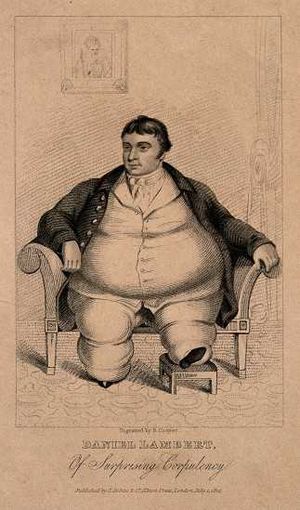Daniel Lambert facts for kids
Daniel Lambert (born March 13, 1770 – died June 21, 1809) was a famous English man known for his incredibly large size. He worked as a prison keeper and bred animals in Leicester, England. After training for four years in Birmingham, he returned to Leicester around 1788. He then took over his father's job as the keeper of Leicester's prison. Daniel was very strong and loved sports. He was known for his skills with dogs, horses, and even fighting cocks.
Around the time he came back to Leicester, Daniel Lambert started gaining weight steadily. This happened even though he was active and didn't eat huge amounts of food. In 1805, the prison where he worked closed down. By this time, he weighed about 318 kilograms (700 pounds). He became the heaviest person known in history up to that point. Because of his size, he couldn't find another job and felt shy, so he stayed mostly at home.
In 1806, Daniel needed money. He decided to put himself on display for people to see. In April 1806, he moved to London and charged visitors to meet him. People were very impressed by how smart and friendly he was. Visiting him became a popular thing to do. After a few months, Daniel got tired of being on display. In September 1806, he returned to Leicester, now wealthy. He continued to breed sporting dogs and go to sports events. Between 1806 and 1809, he went on a few more short tours to raise money.
In June 1809, he suddenly died in Stamford, Lincolnshire. When he passed away, he weighed about 335 kilograms (739 pounds). His coffin needed about 10.4 square meters (112 square feet) of wood. Even though the coffin had wheels and a special ramp was dug for the grave, it took 20 men almost half an hour to move it into the ground. This happened in a new burial area behind St Martin's Church, Stamford. While other people have since become heavier than Daniel Lambert, he is still a well-loved figure in Leicester. In 2009, the Leicester Mercury newspaper called him "one of the city's most cherished icons."
Contents
Daniel Lambert's Early Life
Daniel Lambert was born in his parents' home in Blue Boar Lane, Leicester, on March 13, 1770. His father, also named Daniel Lambert, used to be a hunter for a nobleman. At the time Daniel was born, his father was the keeper of Leicester's prison. Daniel was the oldest of four children. He had two sisters, but his brother died young.
When he was eight years old, Daniel loved to swim. For most of his life, he taught local children how to swim. Daniel's uncle, like his father, also worked with animals as a professional gamekeeper. His mother's father was famous for breeding champion fighting cocks. Daniel grew up loving outdoor sports. He especially enjoyed otter hunting, fishing, shooting, and horse racing. By his late teenage years, Daniel was considered an expert in breeding hunting dogs.
In 1784, he started an apprenticeship at a company called Messrs Taylor & Co in Birmingham. This company made engravings and metal castings. However, the buckles and buttons they specialized in went out of style. The business began to fail. In 1788, Daniel returned to Leicester to help his father at the prison. His father retired soon after, and Daniel took over as the prison keeper. Daniel was a respected keeper. He became friends with many prisoners and tried his best to help them when they went to court.
Daniel's Weight Gain
Daniel Lambert said he didn't eat unusually large amounts of food. But around the time he returned to Leicester, his weight started to increase steadily. By 1793, he weighed about 203 kilograms (448 pounds). He was worried about his health, so he spent his free time exercising. He became so strong that he could easily carry about 254 kilograms (560 pounds). One time, he was watching a dancing bear in the street. His dog got loose and bit the bear. The bear knocked the dog down. Daniel asked the bear's keeper to hold it so he could get his dog. But the keeper took off the bear's muzzle so it could attack the dog. Daniel reportedly hit the bear with a pole and punched its head with his left hand. He knocked it to the ground, allowing his dog to escape.
Even with his growing size, Daniel stayed fit and active. He once walked 11 kilometers (7 miles) from Woolwich to the City of London. He seemed less tired than several average-sized men who were with him. He wasn't very quick, but his size didn't stop him much. He could stand on one leg and kick the other up to 2.1 meters (7 feet) high. He kept teaching swimming in Leicester. He could even stay afloat with two grown men sitting on his back. He didn't like changing his clothes. Every morning, he would wear the same clothes he wore the day before, even if they were still wet. Daniel said he never got sick from this.
By 1801, Daniel's weight had grown to about 254 kilograms (560 pounds). Because of his size, he and his horse couldn't keep up with the hunt. He had to stop hunting. He still loved field sports and kept a group of 30 terrier dogs. By this time, people were worried if he could still do his job as a prison keeper. Old prisons were being replaced with places where people had to do forced labor. In 1805, the old Bridewell prison closed. Daniel lost his job. But the officials in Leicester gave him an annual payment of £50 (worth about £4,000 today). This was to thank him for his excellent work as a prison keeper.
Out of Work
Daniel Lambert's size was huge then. Six normal-sized men could fit inside his waistcoat. Each of his stockings was as big as a sack. His £50 payment wasn't enough to cover his living costs. His size also stopped him from working. He became almost a recluse, meaning he rarely left his home. Stories about his size had spread. Travelers visiting Leicester would find excuses to visit his house. One visitor asked Daniel's servant to let him in, saying he wanted advice about fighting cocks. Daniel leaned out the window and told the servant to "tell the gentleman that I am a shy cock." Another time, he let in a man from Nottingham who wanted advice about a horse's family tree. When Daniel realized the man just wanted to look at him, he told him the horse was "by Impertinence out of Curiosity."
Daniel was sensitive about his weight and refused to be weighed. But around 1805, some friends convinced him to go to a cockfight in Loughborough. Once he squeezed into their carriage, his friends drove the carriage onto a large scale and jumped out. After taking away the weight of the empty carriage (which they had weighed before), they figured out Daniel's weight was now about 318 kilograms (700 pounds). This meant he had become the heaviest person known in history, passing Edward Bright.
Life in London
Even though he was shy, Daniel badly needed money. He saw no other choice but to put himself on display and charge people to see him. On April 4, 1806, he got into a specially built carriage. He traveled from Leicester to his new home at 53 Piccadilly, which was then on the edge of London. For five hours each day, he welcomed visitors into his home. He charged each person one shilling (worth about £5 today).
Daniel shared his knowledge of sports, dogs, and animal breeding with London's wealthy and middle-class people. It quickly became very popular to visit him or become his friend. Many people came back multiple times. One banker visited 20 times, paying the fee each time. During this time in English history, being very large wasn't seen as a bad thing. Daniel was generally seen as a wonder to admire, not someone to stare at or make fun of. His business was an instant success, bringing in about 400 paying visitors daily. His home felt more like a fancy resort than an exhibition. He was happy that his customers treated him with politeness and not just as a show. He made sure everyone in his rooms was civil. All men had to take off their hats. One visitor refused, saying "even if the King were present." Daniel replied, "Then by G——, Sir, you must instantly quit this room, as I do not consider it a mark of respect due to myself, but to the ladies and gentlemen who honor me with my company."
Daniel's popularity led to an imitator, "Master Wybrants, Mr. Lambert in miniature." This boy was shown nearby. A flyer described Wybrants as "Master Wybrants the Modern Hercules, who at the age of 4 Months weighed 39 pounds, measured 2 feet round the Body 15 Inches round the thigh and 8 Inches round the Arm, to be seen at the corner of Sackville Street Piccadilly."
People traveled long distances to see him. Once, 14 people came to London from Guernsey just to see him. Many would spend hours talking to him about animal breeding. A life-sized wax figure of Daniel was shown in London and became very popular. Daniel Lambert soon became a favorite subject for cartoonists. They often drew him as John Bull, a symbol of England. He got along well with the upper classes. He even met King George III once. What they said to each other is not known.
Medical Look at Daniel
Doctors became interested in Daniel Lambert. Soon after he arrived in London, a medical journal published an article about him. They confirmed he weighed about 318 kilograms (700 pounds) and was 1.8 meters (5 feet 11 inches) tall. A full medical check-up found that his body parts worked correctly, and he breathed easily. Daniel was described as active and smart, well-read, and with an excellent memory. He liked to sing and had a normal speaking voice. Doctors found swelling in his feet, legs, and thighs, and a lot of fat in his stomach area. But other than rough skin on his legs from past infections, he had no health problems. Daniel told the doctors he ate normal amounts of regular food. He said that since about 1795, he had only drunk water. Daniel claimed he could walk about 400 meters (a quarter of a mile) without trouble. He slept regularly for no more than eight hours a night, always with his window open. He was never heard to snore. When he woke up, he was fully alert within five minutes and never took naps during the day.
It's hard to know for sure what caused Daniel Lambert's extreme weight. It's unlikely it was caused by a gland problem or a genetic disorder. Besides his weight gain, he didn't show signs of a thyroid problem. None of his many pictures show the "moon face" of someone with a certain hormone disorder. People with some genetic syndromes that cause obesity also have learning difficulties and weak muscles. But everyone who knew Daniel agreed he was very smart, physically strong, and had no health problems except for skin infections and leg vein issues. One person at the time said, "Mr. Lambert scarcely knows what it is to be ailing or indisposed." Daniel's only known emotional problem was feeling a bit sad sometimes while he was in London. Although he had an aunt and uncle who were overweight, his parents and surviving siblings stayed a normal size their whole lives.
So, it's likely that Daniel's weight gain was not from a physical illness. It was probably caused by eating too much and not getting enough exercise. Even though he was big in his teens, he only started gaining weight when he took on the less active job of prison keeper. A book about Daniel, published when he was alive, said that "it was within a year of this appointment that his bulk received the greatest and most rapid encrease." Even though he said he ate little, it's likely that a man with his lifestyle and social standing would have eaten large amounts of meat at social events.
Meeting Józef Boruwłaski
After a few months in London, Daniel was visited by Józef Boruwłaski. He was a dwarf, about 99 centimeters (3 feet 3 inches) tall, and in his seventies. Born in 1739 in a poor family, Boruwłaski was thought to be the last of Europe's court dwarfs. He met Empress Maria Theresa in 1754. After living with a Polish king for a short time, he traveled around Europe, showing himself off. He became a rich man. At age 60, he retired to Durham. He became so popular there that the city paid him to live there, and he was one of its most important citizens. Boruwłaski had an amazing memory. He remembered that Daniel, when he was still working at the metal casting factory and before he got fat, had paid to see him in Birmingham. Boruwłaski said, "I have seen this face twenty years before at Birmingham, but certainly it be another body." He had been told that Daniel's size was a trick. So, he felt Daniel's leg to prove to himself that it was real. The two men compared their clothes. They figured out that one of Daniel's sleeves would have enough fabric to make a whole coat for Boruwłaski. Daniel asked about Boruwłaski's wife. Boruwłaski replied, "No, she is dead, and I am not very sorry, for when I affront her, she put me on the mantle-shelf for punishment."
The meeting of Daniel Lambert and Boruwłaski, the largest and smallest men in the country, caused a lot of public interest. One newspaper said, "It was Sir John Falstaff and Tom Thumb, which must have afforded a double treat to the curious." Boruwłaski lived to be 98 years old. This was despite a money-lender predicting that his small size would make him sick.
Daniel's Frustration
Even though London society generally respected him, the longer Daniel stayed there, the more annoyed he became. He was shy and self-conscious. He was bothered by people constantly asking about the size of his clothes. To one woman who asked about the cost of his coat, he replied, "I cannot pretend to charge my memory with the price, but I can put you into a method of obtaining the information you want. If you think proper to make me a present of a new coat, you will then know exactly what it costs." Another curious person claimed that since his entrance fee was paying for Daniel's clothing, he had the right to know about it. Daniel replied, "Sir, if I knew what part of my next coat your shilling would pay for, I can assure you I would cut out the piece." Daniel figured in 1806 that a full suit of clothes cost him £20 (about £1,600 today).
Back to Leicester
Daniel was smart enough to turn down offers from various show managers. By September 1806, he had returned to Leicester as a wealthy man. He went back to his favorite hobbies: breeding sporting dogs and fighting cocks. A female terrier dog he owned was said to be the best in England. Someone offered him 100 guineas (about £8,000 today) for her. He refused to sell the dog, and she became his lifelong companion. He started attending sports events again. A report on the Leicester Races in September 1806 noted, "Among the distinguished characters upon the turf we were glad to see our old friend, Mr. Daniel Lambert, in apparent high health and spirits." Although he was too heavy to follow hunts on horseback, he used some of the money he earned in London to buy a group of greyhounds. He would watch from his carriage as they chased hares in the Leicestershire countryside.
In December 1806, Daniel went on a short tour to raise money. He showed himself in Birmingham and Coventry. Early the next year, he returned to London and stayed in the popular Leicester Square. There, he became ill. His doctor thought his illness might have been caused by the polluted London air. Daniel returned to Leicester. He recovered, and later in 1807, he went on a series of tours around England.
In the summer of 1808, Daniel briefly returned to London. He sold a pair of spaniel dogs for 75 guineas (about £6,000 today) at Tattersalls. Later that year, he showed himself in York. In June 1809, he started another tour of East Anglia. It was supposed to end in Stamford during the Stamford Races. Some say this tour was meant to be his last, as he was rich enough to retire. While on the tour, Daniel was weighed in Ipswich. His weight was about 335 kilograms (739 pounds). He could no longer use stairs. So, on June 20, he rented rooms on the ground floor of the Waggon & Horses inn at 47 High Street, Stamford.
Daniel's Death
After arriving in Stamford, Daniel sent a message to the Stamford Mercury newspaper. He ordered advertisements and flyers. He said that "as the Mountain could not wait upon Mahomet, Mahomet would go to the mountain." This meant he wanted the printer to visit him at the Waggon & Horses to talk about his printing needs. That evening, Daniel was in bed and said he felt tired. But he was still able to discuss his needs with the printer. He was eager for the flyers to be delivered on time.
On the morning of June 21, Daniel woke up at his usual time and seemed healthy. As he started to shave, he complained of trouble breathing. Ten minutes later, he collapsed and died.
There was no autopsy, so the exact cause of Daniel's death is unknown. Many sources say he died from a fatty heart or stress on his heart due to his size. However, his actions before his death don't match someone with heart failure. Witnesses agree that on the morning he died, he seemed fine before he became short of breath and collapsed. Some experts believe the most likely explanation for his death, given his symptoms and health history, is a sudden pulmonary embolism (a blockage in the lung's artery).
Daniel's Burial
Daniel's friends paid for a large gravestone. It reads: In Remembrance of that Prodigy in Nature. DANIEL LAMBERT. a Native of Leicester: who was possessed of an exalted and convivial Mind and in personal Greatness had no Competitor He measured three Feet one Inch round the Leg nine Feet four Inches round the Body and weighed Fifty two Stone eleven Pounds! He departed this Life on the 21st of June 1809 Aged 39 years As a Testimony of Respect this Stone is erected by his Friends in Leicester
After Daniel's Death
In late 1809, John Drakard published The life of that wonderful and extraordinary heavy man, the late Danl. Lambert, from his birth to the moment of his dissolution, with an account of men noted for their corpulency, and other interesting matter. This was the first full book about Daniel's life after he died. Daniel's record as the heaviest person in history was soon broken by an American named Mills Darden (1799–1857). But Daniel had become a very famous figure. Almost everything connected to him was saved. His clothes and belongings were sold at auction to collectors. Many of them are now kept in museums.
Across England, many pubs and inns were renamed after Daniel Lambert, especially in Leicester and Stamford. The Daniel Lambert pub at 12 Ludgate Hill in London was well-known. It had a large painting of Daniel Lambert and his walking stick on display. James Dixon, who owned the Ram Jam Inn in Stamford, bought the suit of clothes Daniel was wearing when he died. He put it on display and renamed his inn "The Daniel Lambert."
The phrase "Daniel Lambert" became a common way to describe any fat man in English speech and writing. His name continued to be used this way long after people forgot the details of his life. In 1852, Charles Dickens said that "Lambert's name is known better than his history." Dickens's book Nicholas Nickleby compares the very large George IV to Daniel. William Makepeace Thackeray used the term in Vanity Fair to describe the large Joseph Sedley. He also used it in The Luck of Barry Lyndon for the fat servant Tim. As time went on, "Daniel Lambert" came to mean anything unusually large. For example, a book called The Study of Sociology used the phrase "a Daniel Lambert of learning." In 1874, The Times newspaper reviewed a French play. A character in the play was named "Daniel Lambert." The newspaper noted that the name is "always associated in the English mind with the notion of obesity." In 1907, almost 100 years after Daniel's death, the Château de Chambord was called "the Daniel Lambert among châteaux" because of its huge size. Nellie Lambert Ensall, who was the heaviest woman in Britain in 1910, claimed to be Daniel Lambert's great-granddaughter. But this is probably not true, as Daniel was never married and likely had no children.
In 1838, a book called The English Annual published a series of poems. They were supposedly written by Daniel Lambert and found among his papers after his death. No source published during Daniel's lifetime mentions him being interested in poetry or any reading other than sports magazines. It's also unclear why his papers would have been with him in Stamford when he died, instead of at his home in Leicester. The person who found the poems was only named "Omega." It is likely that the poems were a trick.
P. T. Barnum and General Tom Thumb
P. T. Barnum and General Tom Thumb (Charles Sherwood Stratton), who was 63.5 centimeters (25 inches) tall, visited Stamford in 1846. They gave one of Tom Thumb's costumes to James Dixon to display next to Daniel's. General Tom Thumb visited Stamford again in 1859. He was tied up inside one of Daniel's stockings. In 1866, General Tom Thumb visited Stamford again with his equally short wife, Lavinia Warren, her sister Minnie Warren, and another famous dwarf, Commodore Nutt. All four of them were able to pass through the knee of Daniel's pants together. In 1866, Daniel's and Tom Thumb's clothes were sold to the Old London Tavern in Stamford. They were later owned by Stamford Museum. (In June 2010, it was announced that the Stamford Museum would close in June 2011, and its collection would move to Stamford Library.)
The wax figure of Daniel from 1806 was sent to the United States. By 1813, it was on display in New Haven, Connecticut. By 1828, the figure was shown in the Boston Vauxhall Gardens, dressed in a full set of Daniel's clothes. It was later bought by P. T. Barnum and displayed at Barnum's American Museum in New York. But the museum was destroyed by fire in 1865. Even though workers tried to save the wax figure, it melted in the heat and was destroyed.
Daniel in Popular Memory
Daniel Lambert is still a popular figure in Leicester. In 2009, the Leicester Mercury newspaper called him "one of the city's most cherished icons." Several local pubs and businesses are named after him. Sue Townsend's play The Ghost of Daniel Lambert tells the story of Daniel's ghost watching sadly as Leicester's old town center is torn down and rebuilt in the 1960s. The play first showed at Leicester's Haymarket Theatre in 1981. Daniel is also popular in Stamford. The local football team, Stamford A.F.C., is nicknamed "The Daniels" after him.
A set of Daniel's clothes, along with his armchair, walking stick, riding crop, and prayer book, are always on display at the Newarke Houses Museum in Leicester. Stamford Museum showed a tailor's dummy dressed in Daniel Lambert's clothes, as if they were being made for him, plus his hat and a portrait. The Daniel Lambert pub in Ludgate Hill no longer exists. The items that used to be displayed there are now permanently shown at the George Hotel in Stamford. The Daniel Lambert pub in Stamford has also closed.
In 2009, on the 200th anniversary of his death, Leicester celebrated Daniel Lambert Day. Over 800 people attended an event in his name at Newarke Houses Museum.
See also
 In Spanish: Daniel Lambert para niños
In Spanish: Daniel Lambert para niños


